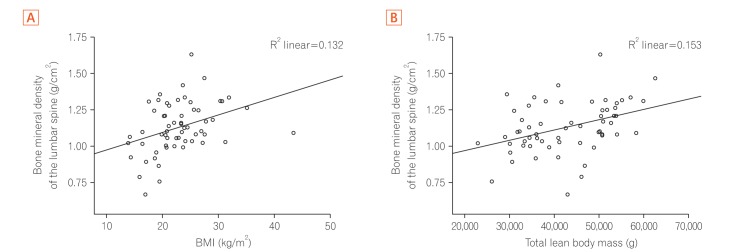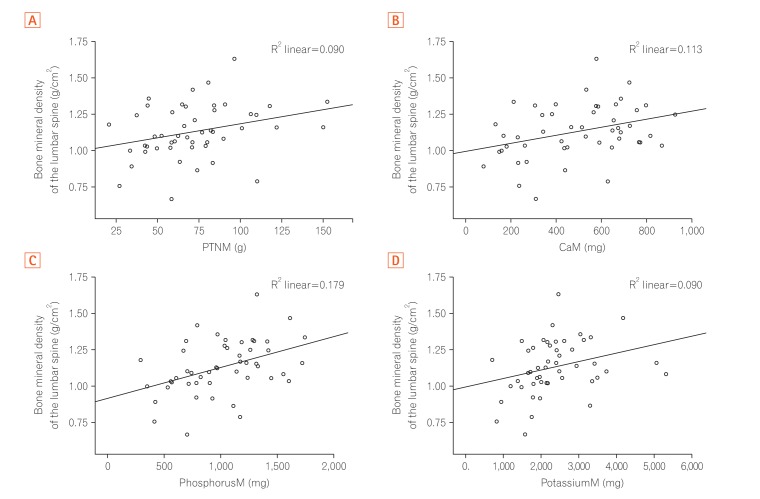Intest Res.
2018 Jul;16(3):436-444. 10.5217/ir.2018.16.3.436.
What nutritional factors influence bone mineral density in Crohn's disease patients?
- Affiliations
-
- 1Department of Sciences of Nutrition, School of Nutrition, Universidade Federal da Bahia, Salvador, Brazil. raquelrocha2@yahoo.com.br
- 2Gastroenterology Unit, University Hospital Professor Edgard Santos, Universidade Federal da Bahia, Salvador, Brazil.
- 3Department of Life Sciences, Universidade do Estado da Bahia, Salvador, Brazil.
- KMID: 2417656
- DOI: http://doi.org/10.5217/ir.2018.16.3.436
Abstract
- BACKGROUND/AIMS
Bone mineral density (BMD) is often low in patients with Crohn's disease (CD). This study aimed to evaluate the association between nutritional factors and BMD in a group of CD patients.
METHODS
CD patients 18 years of age or older were included. The body mass index (BMI), waist circumference (WC) and dietary intake were evaluated during two 24-hour recalls. Bone densitometry was performed by dual-energy X-ray absorptiometry of the full body to assess body composition and of the lumbar vertebrae and femoral neck to assess BMD.
RESULTS
In the 60 patients evaluated, there was no association between BMD and disease activity or between BMD and disease duration. We observed moderate correlations between BMD in at least one of the evaluated sites and BMI, lean mass, WC, and protein, calcium, phosphorus and magnesium dietary intakes (P < 0.05). In the linear regression analysis for spinal BMD, only BMI and calcium dietary intake remained associated (P < 0.05). In the linear regression analysis for femoral BMD, WC and phosphorus intake continued to be significant in the final model, although they had low explanatory power for BMD (P < 0.05).
CONCLUSIONS
The prevalence of low BMD was high in CD patients. BMI, WC, calcium and phosphorus dietary intake were positively correlated with BMD.
MeSH Terms
Figure
Reference
-
1. Siffledeen JS, Fedorak RN, Siminoski K, et al. Bones and Crohn's: risk factors associated with low bone mineral density in patients with Crohn's disease. Inflamm Bowel Dis. 2004; 10:220–228. PMID: 15290915.2. Drake MT, Murad MH, Mauck KF, et al. Clinical review: risk factors for low bone mass-related fractures in men: a systematic review and meta-analysis. J Clin Endocrinol Metab. 2012; 97:1861–1870. PMID: 22466344.
Article3. Genaro PS, Pereira GA, Pinheiro MM, Szejnfeld VL, Martini LA. Influence of body composition on bone mass in postmenopausal osteoporotic women. Arch Gerontol Geriatr. 2010; 51:295–298. PMID: 20096469.
Article4. Lee N, Radford-Smith GL, Forwood M, Wong J, Taaffe DR. Body composition and muscle strength as predictors of bone mineral density in Crohn's disease. J Bone Miner Metab. 2009; 27:456–463. PMID: 19333683.
Article5. Leslie WD, Miller N, Rogala L, Bernstein CN. Body mass and composition affect bone density in recently diagnosed inflammatory bowel disease: the Manitoba IBD Cohort Study. Inflamm Bowel Dis. 2009; 15:39–46. PMID: 18623166.
Article6. Alastair F, Emma G, Emma P. Nutrition in inflammatory bowel disease. JPEN J Parenter Enteral Nutr. 2011; 35:571–580. PMID: 21825089.
Article7. Nascimento AT, Rocha R, Coqueiro FG, Santana GO, Lyra AC. Does obesity complicate inflammatory bowel diseases? J Crohns Colitis. 2012; 6:1041. DOI: 10.1016/j.crohns.2012.06.008. PMID: 22732365.
Article8. Hartman C, Eliakim R, Shamir R. Nutritional status and nutritional therapy in inflammatory bowel diseases. World J Gastroenterol. 2009; 15:2570–2578. PMID: 19496185.
Article9. Sousa Guerreiro C, Cravo M, Costa AR, et al. A comprehensive approach to evaluate nutritional status in Crohn's patients in the era of biologic therapy: a case-control study. Am J Gastroenterol. 2007; 102:2551–2556. PMID: 17680845.
Article10. Kim J, Kim B, Lee H, Choi H, Won C. The relationship between prevalence of osteoporosis and proportion of daily protein intake. Korean J Fam Med. 2013; 34:43–48. PMID: 23372905.
Article11. Hannan MT, Tucker KL, Dawson-Hughes B, Cupples LA, Felson DT, Kiel DP. Effect of dietary protein on bone loss in elderly men and women: the Framingham Osteoporosis Study. J Bone Miner Res. 2000; 15:2504–2512. PMID: 11127216.
Article12. Nieves JW. Osteoporosis: the role of micronutrients. Am J Clin Nutr. 2005; 81:1232S–1239S. PMID: 15883457.
Article13. Bonjour JP, Guéguen L, Palacios C, Shearer MJ, Weaver CM. Minerals and vitamins in bone health: the potential value of dietary enhancement. Br J Nutr. 2009; 101:1581–1596. PMID: 19335926.
Article14. Reed CA, Nichols DL, Bonnick SL, DiMarco NM. Bone mineral density and dietary intake in patients with Crohn's disease. J Clin Densitom. 1998; 1:33–40. PMID: 15304911.
Article15. Abitbol V, Mary JY, Roux C, et al. Osteoporosis in inflammatory bowel disease: effect of calcium and vitamin D with or without fluoride. Aliment Pharmacol Ther. 2002; 16:919–927. PMID: 11966500.
Article16. Harvey RF, Bradshaw JM. A simple index of Crohn's-disease activity. Lancet. 1980; 1:514. PMID: 6102236.
Article17. Silverberg MS, Satsangi J, Ahmad T, et al. Toward an integrated clinical, molecular and serological classification of inflammatory bowel disease: report of a Working Party of the 2005 Montreal World Congress of Gastroenterology. Can J Gastroenterol. 2005; 19(Suppl A):5A–36A.
Article18. Leslie M, Mikanowicz C. Assessment of body composition in the healthy adult. J Am Acad Nurse Pract. 1997; 9:123–127. PMID: 9287652.
Article19. Obesity: preventing and managing the global epidemic. Report of a WHO consultation. World Health Organ Tech Rep Ser. 2000; 894:i–xii. 1–253. PMID: 11234459.20. Institute of Medicine (US) Standing Committee on the Scientific Evaluation of Dietary Reference Intakes. Dietary ReferenceIntakes for calcium, phosphorus, magnesium, vitamin D, and fluoride. Washington, DC: National Academies Press (US);1997.21. Trumbo P, Schlicker S, Yates AA, Poos M. Food and Nutrition Board of the Institute of Medicine, The National Academies. Dietary Reference Intakes for energy, carbohydrate, fiber, fat, fatty acids, cholesterol, protein and amino acids. J Am Diet Assoc. 2002; 102:1621–1630. PMID: 12449285.
Article22. Ross AC, Manson JE, Abrams SA, et al. The 2011 Dietary Reference Intakes for calcium and vitamin D: what dietetics practitioners need to know. J Am Diet Assoc. 2011; 111:524–527. PMID: 21443983.
Article23. Kanis JA. Assessment of fracture risk and its application to screening for postmenopausal osteoporosis: synopsis of a WHO report. WHO Study Group. Osteoporos Int. 1994; 4:368–381. PMID: 7696835.
Article24. Habtezion A, Silverberg MS, Parkes R, Mikolainis S, Steinhart AH. Risk factors for low bone density in Crohn's disease. Inflamm Bowel Dis. 2002; 8:87–92. PMID: 11854605.
Article25. Cravo M, Guerreiro CS, dos Santos PM, et al. Risk factors for metabolic bone disease in Crohn's disease patients. Inflamm Bowel Dis. 2010; 16:2117–2124. PMID: 20848459.
Article26. Ezzat Y, Hamdy K. The frequency of low bone mineral density and its associated risk factors in patients with inflammatory bowel diseases. Int J Rheum Dis. 2010; 13:259–265. PMID: 20704624.
Article27. Lima CA, Lyra AC, Mendes CM, et al. Bone mineral density and inflammatory bowel disease severity. Braz J Med Biol Res. 2017; 50:e6374. DOI: 10.1590/1414-431X20176374. PMID: 29069227.
Article28. Koutroubakis IE, Zavos C, Damilakis J, et al. Low bone mineral density in Greek patients with inflammatory bowel disease: prevalence and risk factors. Ann Gastroenterol. 2011; 24:41–46. PMID: 24714255.29. Atreja A, Aggarwal A, Licata AA, Lashner BA. Low body mass index can identify majority of osteoporotic inflammatory bowel disease patients missed by current guidelines. ScientificWorldJournal. 2012; 2012:807438. DOI: 10.1100/2012/807438. PMID: 22645457.
Article30. Targownik LE, Leslie WD, Carr R, et al. Longitudinal change in bone mineral density in a population-based cohort of patients with inflammatory bowel disease. Calcif Tissue Int. 2012; 91:356–363. PMID: 22983212.
Article31. Farrell VA, Harris M, Lohman TG, et al. Comparison between dietary assessment methods for determining associations between nutrient intakes and bone mineral density in postmenopausal women. J Am Diet Assoc. 2009; 109:899–904. PMID: 19394478.
Article
- Full Text Links
- Actions
-
Cited
- CITED
-
- Close
- Share
- Similar articles
-
- The relationship of maturation value of vaginal epithelium and bone mineral density in postmenopausal women
- Nutritional Status and Growth in Korean Children with Crohn's Disease: A Single-Center Study
- Bone Mineral Density in Newly Diagnosed Patients with Inflammatory Bowel Disease
- Nutritional Support in Patients with Inflammatory Bowel Diseases
- Influence of the Reproductive Factor and Life Style Factor in Postmenopausal Women's Bone Mineral Density




